Max F. Burg
International Max Planck Research School for Intelligent Systems, University of Tuebingen, Germany, Institute for Bioinformatics and Medical Informatics, University of Tuebingen, Germany, Institute of Computer Science and Campus Institute Data Science, University of Goettingen, Germany, Institute for Theoretical Physics, University of Tuebingen, Germany
Visual Data-Type Understanding does not emerge from Scaling Vision-Language Models
Oct 16, 2023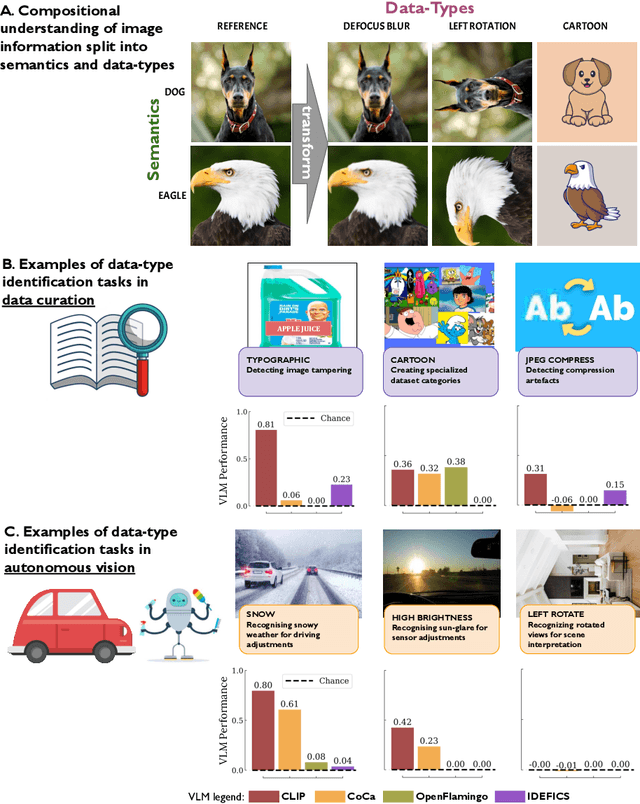

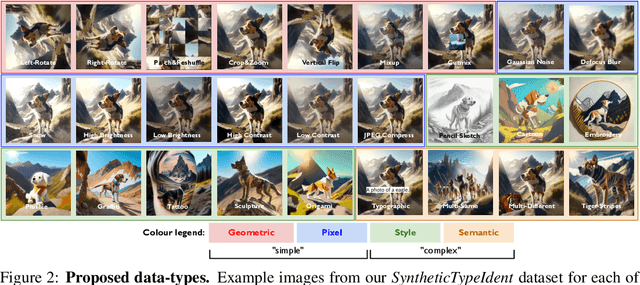

Abstract:Recent advances in the development of vision-language models (VLMs) are yielding remarkable success in recognizing visual semantic content, including impressive instances of compositional image understanding. Here, we introduce the novel task of Visual Data-Type Identification, a basic perceptual skill with implications for data curation (e.g., noisy data-removal from large datasets, domain-specific retrieval) and autonomous vision (e.g., distinguishing changing weather conditions from camera lens staining). We develop two datasets consisting of animal images altered across a diverse set of 27 visual data-types, spanning four broad categories. An extensive zero-shot evaluation of 39 VLMs, ranging from 100M to 80B parameters, shows a nuanced performance landscape. While VLMs are reasonably good at identifying certain stylistic \textit{data-types}, such as cartoons and sketches, they struggle with simpler data-types arising from basic manipulations like image rotations or additive noise. Our findings reveal that (i) model scaling alone yields marginal gains for contrastively-trained models like CLIP, and (ii) there is a pronounced drop in performance for the largest auto-regressively trained VLMs like OpenFlamingo. This finding points to a blind spot in current frontier VLMs: they excel in recognizing semantic content but fail to acquire an understanding of visual data-types through scaling. By analyzing the pre-training distributions of these models and incorporating data-type information into the captions during fine-tuning, we achieve a significant enhancement in performance. By exploring this previously uncharted task, we aim to set the stage for further advancing VLMs to equip them with visual data-type understanding. Code and datasets are released at https://github.com/bethgelab/DataTypeIdentification.
HARD: Hard Augmentations for Robust Distillation
May 25, 2023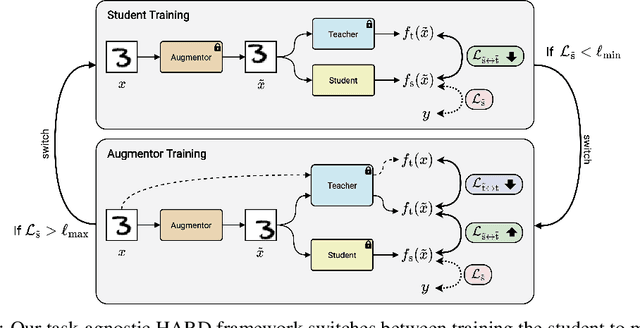
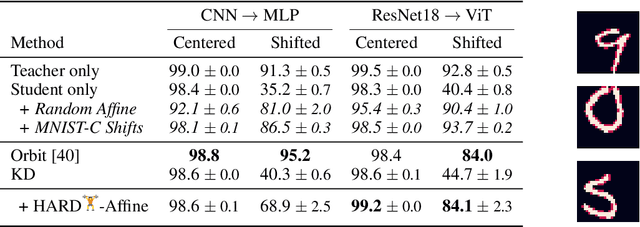
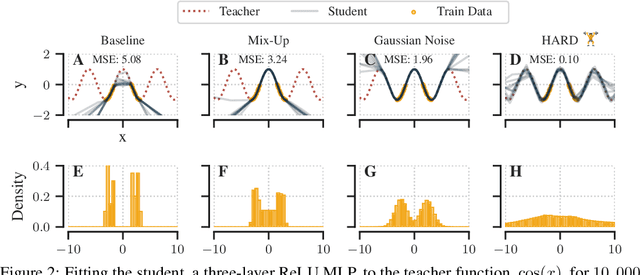
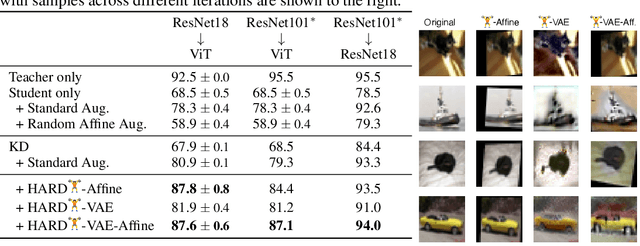
Abstract:Knowledge distillation (KD) is a simple and successful method to transfer knowledge from a teacher to a student model solely based on functional activity. However, current KD has a few shortcomings: it has recently been shown that this method is unsuitable to transfer simple inductive biases like shift equivariance, struggles to transfer out of domain generalization, and optimization time is magnitudes longer compared to default non-KD model training. To improve these aspects of KD, we propose Hard Augmentations for Robust Distillation (HARD), a generally applicable data augmentation framework, that generates synthetic data points for which the teacher and the student disagree. We show in a simple toy example that our augmentation framework solves the problem of transferring simple equivariances with KD. We then apply our framework in real-world tasks for a variety of augmentation models, ranging from simple spatial transformations to unconstrained image manipulations with a pretrained variational autoencoder. We find that our learned augmentations significantly improve KD performance on in-domain and out-of-domain evaluation. Moreover, our method outperforms even state-of-the-art data augmentations and since the augmented training inputs can be visualized, they offer a qualitative insight into the properties that are transferred from the teacher to the student. Thus HARD represents a generally applicable, dynamically optimized data augmentation technique tailored to improve the generalization and convergence speed of models trained with KD.
A data augmentation perspective on diffusion models and retrieval
Apr 20, 2023Abstract:Diffusion models excel at generating photorealistic images from text-queries. Naturally, many approaches have been proposed to use these generative abilities to augment training datasets for downstream tasks, such as classification. However, diffusion models are themselves trained on large noisily supervised, but nonetheless, annotated datasets. It is an open question whether the generalization capabilities of diffusion models beyond using the additional data of the pre-training process for augmentation lead to improved downstream performance. We perform a systematic evaluation of existing methods to generate images from diffusion models and study new extensions to assess their benefit for data augmentation. While we find that personalizing diffusion models towards the target data outperforms simpler prompting strategies, we also show that using the training data of the diffusion model alone, via a simple nearest neighbor retrieval procedure, leads to even stronger downstream performance. Overall, our study probes the limitations of diffusion models for data augmentation but also highlights its potential in generating new training data to improve performance on simple downstream vision tasks.
The Sensorium competition on predicting large-scale mouse primary visual cortex activity
Jun 17, 2022
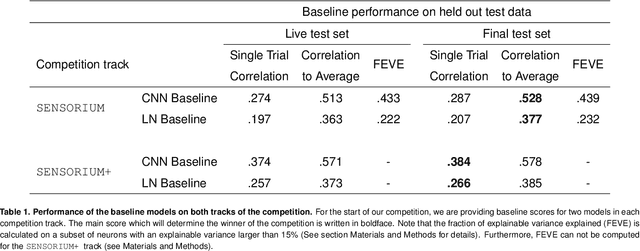
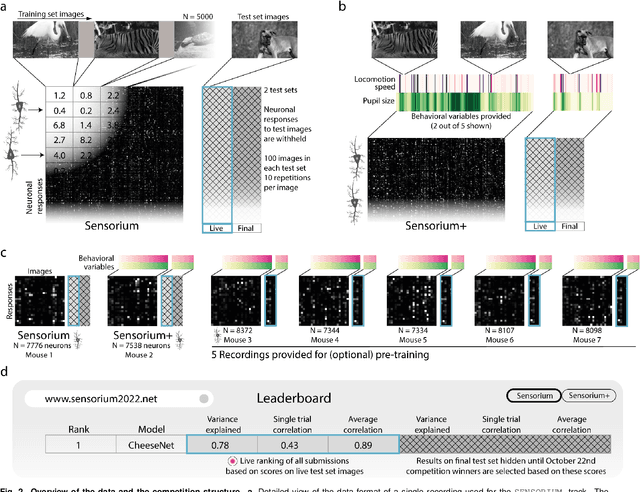
Abstract:The neural underpinning of the biological visual system is challenging to study experimentally, in particular as the neuronal activity becomes increasingly nonlinear with respect to visual input. Artificial neural networks (ANNs) can serve a variety of goals for improving our understanding of this complex system, not only serving as predictive digital twins of sensory cortex for novel hypothesis generation in silico, but also incorporating bio-inspired architectural motifs to progressively bridge the gap between biological and machine vision. The mouse has recently emerged as a popular model system to study visual information processing, but no standardized large-scale benchmark to identify state-of-the-art models of the mouse visual system has been established. To fill this gap, we propose the Sensorium benchmark competition. We collected a large-scale dataset from mouse primary visual cortex containing the responses of more than 28,000 neurons across seven mice stimulated with thousands of natural images, together with simultaneous behavioral measurements that include running speed, pupil dilation, and eye movements. The benchmark challenge will rank models based on predictive performance for neuronal responses on a held-out test set, and includes two tracks for model input limited to either stimulus only (Sensorium) or stimulus plus behavior (Sensorium+). We provide a starting kit to lower the barrier for entry, including tutorials, pre-trained baseline models, and APIs with one line commands for data loading and submission. We would like to see this as a starting point for regular challenges and data releases, and as a standard tool for measuring progress in large-scale neural system identification models of the mouse visual system and beyond.
 Add to Chrome
Add to Chrome Add to Firefox
Add to Firefox Add to Edge
Add to Edge